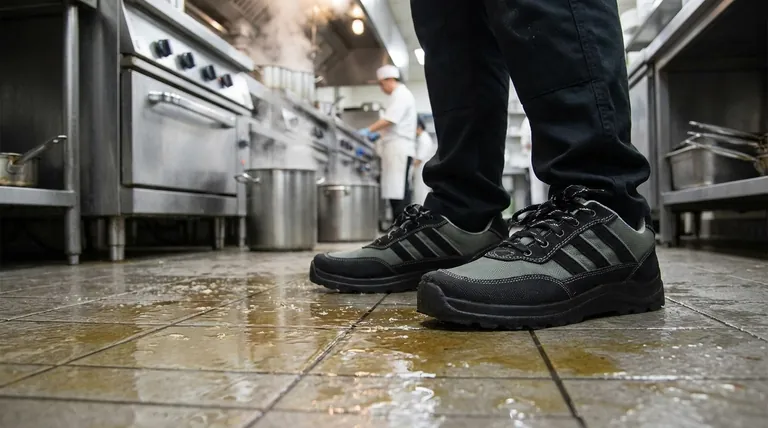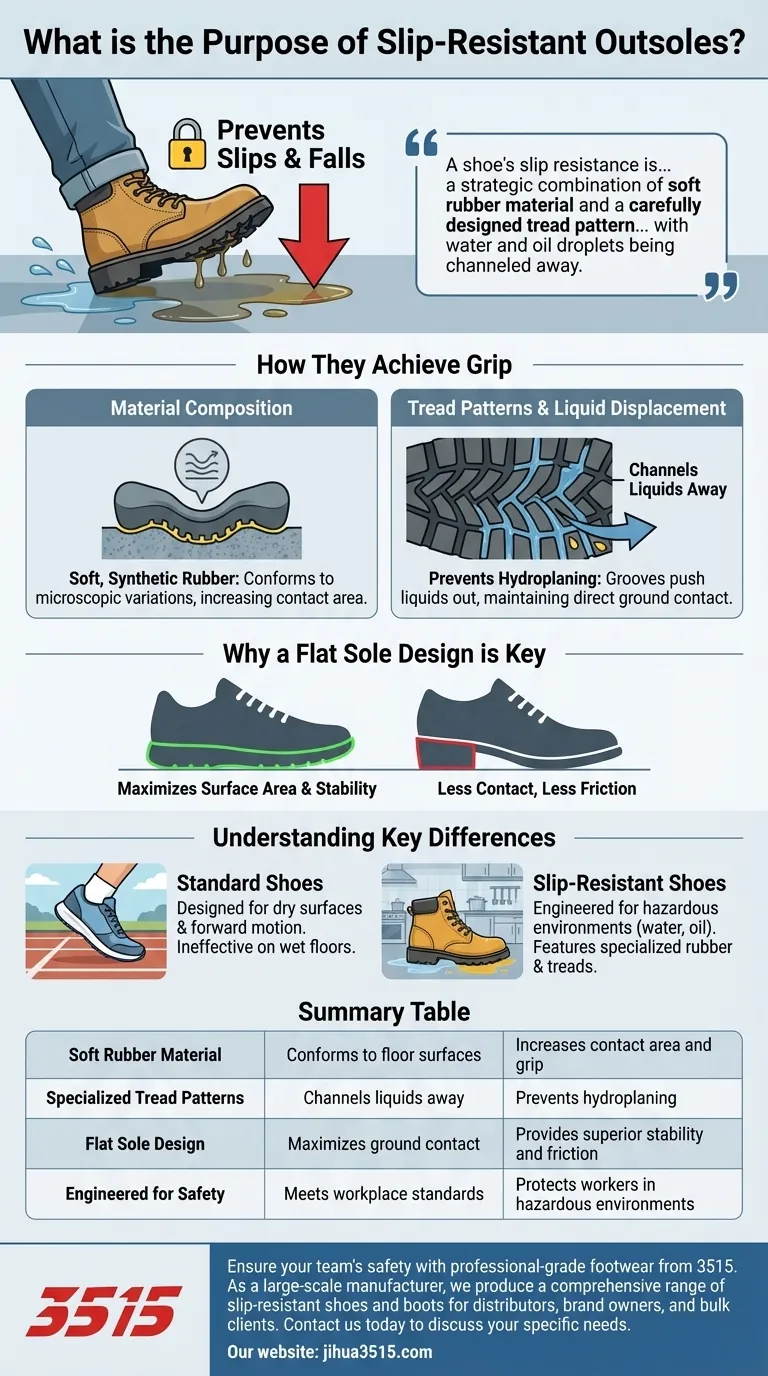The fundamental purpose of a slip-resistant outsole is to prevent slips and falls on hazardous surfaces. These specialized soles are engineered with unique materials and tread patterns designed to maximize friction and maintain grip on floors contaminated with water, oil, or other slick substances.
A shoe's slip resistance is not determined by a single feature, but by a strategic combination of soft rubber material and a carefully designed tread pattern that actively channels liquids away to maintain direct contact with the ground.

How Slip-Resistant Outsoles Achieve Grip
True slip resistance is a function of both material science and physical design. Each element plays a distinct role in ensuring stability on an otherwise unstable surface.
The Role of Material Composition
The primary material used is a soft, synthetic rubber. Unlike the harder compounds found in many standard shoes, this softer rubber is more pliable and can better conform to microscopic variations in a floor's surface, significantly increasing the contact area and therefore the grip.
The Critical Function of Tread Patterns
The grooves, or treads, on the outsole are its most important functional feature. These channels are specifically designed to push liquids like water and oil out from under the shoe. This action prevents a layer of liquid from forming between the sole and the floor—a phenomenon known as hydroplaning—which is a primary cause of slips. Many effective designs use an interlocked tread pattern to maximize this liquid displacement.
Why a Flat Sole Design is Key
Most slip-resistant work shoes feature a relatively flat sole. This design maximizes the amount of surface area in direct contact with the ground at any given moment. More contact equals greater friction and stability, providing a more secure footing compared to shoes with a pronounced heel or curved sole.
Understanding the Key Differences
Not all rubber soles are created equal. The distinction between a standard shoe and a true slip-resistant shoe lies in their intended function and design.
The Problem with Standard Shoes
Most casual or athletic shoes, including running shoes, are not designed to meet workplace safety standards for slip resistance. Their treads are typically designed for grip during forward motion on solid, dry surfaces. On a wet or oily floor, these patterns are ineffective at channeling liquid away, making them unreliable and unsafe.
Engineered for Hazardous Environments
Slip-resistant shoes are a form of specialty safety footwear. They are engineered from the ground up for workers in environments where slippery floors are a constant hazard, such as commercial kitchens, hospitals, and manufacturing facilities.
Beyond the Outsole
While the outsole is the core component, these shoes often include other safety and comfort features. Padded collars provide ankle support, and many models incorporate water-resistant uppers to keep the wearer's feet dry and comfortable throughout a demanding shift.
Making the Right Choice for Your Goal
Selecting the correct footwear is essential for aligning performance with your specific safety needs.
- If your primary focus is workplace safety in slick environments: You must use certified slip-resistant footwear designed specifically for wet and oily surfaces.
- If your primary focus is athletic performance: Stick to shoes designed for your sport, as they prioritize cushioning and support for forward motion over grip on flat, slick floors.
- If your primary focus is everyday casual use: Standard rubber-soled shoes offer sufficient grip for most daily conditions but should never be substituted for proper safety shoes in a hazardous environment.
Ultimately, choosing footwear with the correct outsole is a critical decision for ensuring your personal safety in any given environment.
Summary Table:
| Feature | Purpose | Key Benefit |
|---|---|---|
| Soft Rubber Material | Conforms to floor surfaces | Increases contact area and grip |
| Specialized Tread Patterns | Channels liquids away | Prevents hydroplaning |
| Flat Sole Design | Maximizes ground contact | Provides superior stability and friction |
| Engineered for Safety | Meets workplace standards | Protects workers in hazardous environments |
Ensure your team's safety with professional-grade footwear from 3515.
As a large-scale manufacturer, we produce a comprehensive range of slip-resistant shoes and boots for distributors, brand owners, and bulk clients. Our production capabilities ensure your workforce has the reliable grip and protection needed for demanding environments like commercial kitchens, hospitals, and manufacturing facilities.
Contact us today to discuss your specific needs and discover how 3515 can be your trusted partner in safety footwear.
Visual Guide

Related Products
- Durable Rubber-Soled Utility Shoes for Wholesale & Custom Brand Manufacturing
- Premium Safety Shoes with Rotating Buckle Safety Sneakers
- Customizable Slip-On Safety Shoes Direct from the Factory for Wholesale
- Factory-Direct Wholesale Canvas Boots with High-Traction Rubber Soles
- Wholesale Safety Footwear Manufacturer for Bulk & Custom OEM Orders
People Also Ask
- What are rubber soled shoes? The Ultimate Guide to Durable, All-Weather Footwear
- What makes rubber sole shoes an economical and practical choice? Unmatched Durability & All-Weather Value
- Why should we wear rubber soled shoes? Unlock Superior Safety and Durability
- What are the main applications of vulcanized rubber? Unlock Durability for Tires, Footwear & More
- What are the disadvantages of leather shoe soles? Key Limitations in Traction & Durability



















